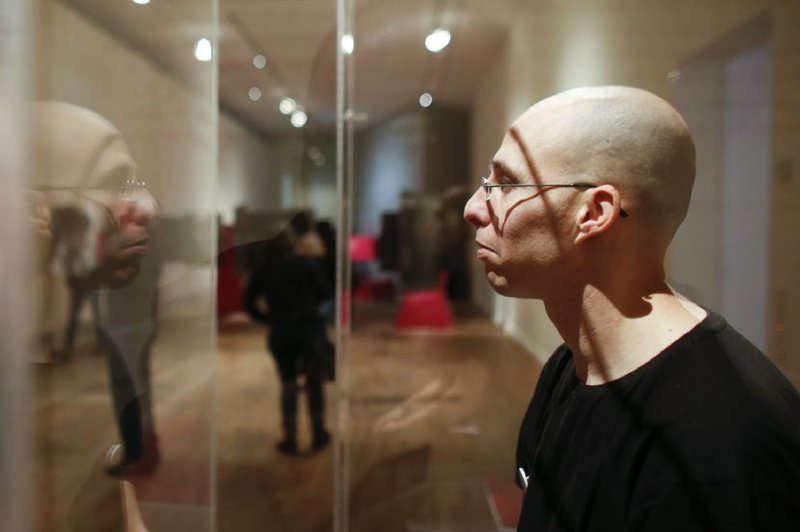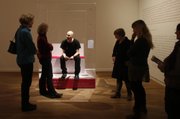BERLIN - “Are there still Jews in Germany?” “Are the Jews a chosen people?”
Nearly 70 years after the Holocaust, there is no more sensitive an issue in German life than the role of Jews. With fewer than 200,000 Jews among Germany’s 82 million people, few Germans born after World War II know any Jews or much about them.
To help educate postwar generations, an exhibit at the Jewish Museum features a Jewish man or woman seated inside a glass box for two hours a day through August to answer visitors’ questions about Jews and Jewish life. The base of the box asks: “Are there still Jews in Germany?”
“A lot of our visitors don’t know any Jews and have questions they want to ask,” museum official Tina Luedecke said. “With this exhibition we offer an opportunity for those people to know more about Jews and Jewish life.”
But not everybody thinks putting a Jew on display is the best way to build understanding and mutual respect.
Since the exhibit - “The Whole Truth, everything you wanted to know about Jews” - opened in March, the “Jew in the Box,” as it is popularly known, has drawn sharp criticism within the Jewish community- especially in the city where the Nazis orchestrated the slaughter of 6 million Jews until Adolf Hitler’s defeat in 1945.
“Why don’t they give him a banana and a glass of water, turn up the heat and make the Jew feel really cozy in his glass box,” prominent Berlin Jewish community figure Stephan Kramer told The Associated Press. “They actually asked me if I wanted to participate. But I told them I’m not available.”
The exhibit is reminiscent of Holocaust architect Adolf Eichmann sitting in a glass booth at the 1961 trial in Israel that led to his execution. And it’s certainly more provocative than British actress Tilda Swinton sleeping in a glass box at a recent performance at the Museum of Modern Art in New York.
Eran Levy, an Israeli who has lived in Berlin for years, was horrified by the idea of presenting a Jew as a museum piece, even if to answer Germans’ questions about Jewish life.
“It’s a horrible thing to do - completely degrading and not helpful,” he said. “The Jewish Museum absolutely missed the point if they wanted to do anything to improve the relations between Germans and Jews.”
But several of the volunteers, including German Jews and Israelis living in Berlin, said the experience in the box is little different from what they go through as Jews living in the country that produced the Nazis.
“With so few of us, you almost inevitably feel like an exhibition piece,” volunteer Leeor Englander said. “Once you’ve been ‘outed’ as a Jew, you always have to be the expert and answer all questions regarding anything related to religion, Israel, the Holocaust and so on.”
Museum curator Miriam Goldmann, who is Jewish, believes the exhibit’s provocative “in your face” approach is the best way to overcome the emotional barriers and deal with a subject that remains painful for Jews and non-Jews.
“We wanted to provoke, that’s true, and some people may find the show outrageous or objectionable,” Goldmann said. “But that’s fine by us.”
On a recent day, several visitors kept returning to ask questions of Ido Porat, a 33-year-old Israeli seated on a white bench with a pink cushion.
One woman wanted to know what to take her hosts for a Shabbat dinner in Israel. Another asked why only Jewish men and not women wear yarmulkes. A third inquired about Judaism and homosexuality.
Viola Mohaupt-Zitfin, 53, asked if Porat felt welcome as a Jew living among Germans “considering our past and all that.”
Yes, Porat said, Germany is a good place to live, even as a Jew. But the country could do even more to come to terms with its Nazi past, he added. He advised the would-be traveler that anything is permissible to take to a Shabbat dinner as long as it’s not pork.
“I feel a bit like an animal in the zoo, but in reality that’s what it’s like being a Jew in Germany,” Porat said. “You are a very interesting object to most people here.”
Dekel Peretz, one of the volunteers in the glass box, said many Germans have an image of Jews that is far removed from the reality of contemporary Jewish life.
“They associate Jews with the Holocaust and the Nazi era,” he said. “Jews don’t have a history before or after. In Germany, Jews have been stereotyped as victims. It is important that people here get to know Jews to see that Jews are alive and that we have individual histories. I hope that this exhibit can help.”
Still, not everyone believes this is the best way to promote understanding.
Rabbi Yehuda Teichtal from the Jewish Chabad community in Berlin said Germans who are really interested in Jews and Judaism should visit the community’s educational center.
“Here Jews will be happy to answer questions without sitting in a glass box,” he said.
Religion, Pages 12 on 04/06/2013


